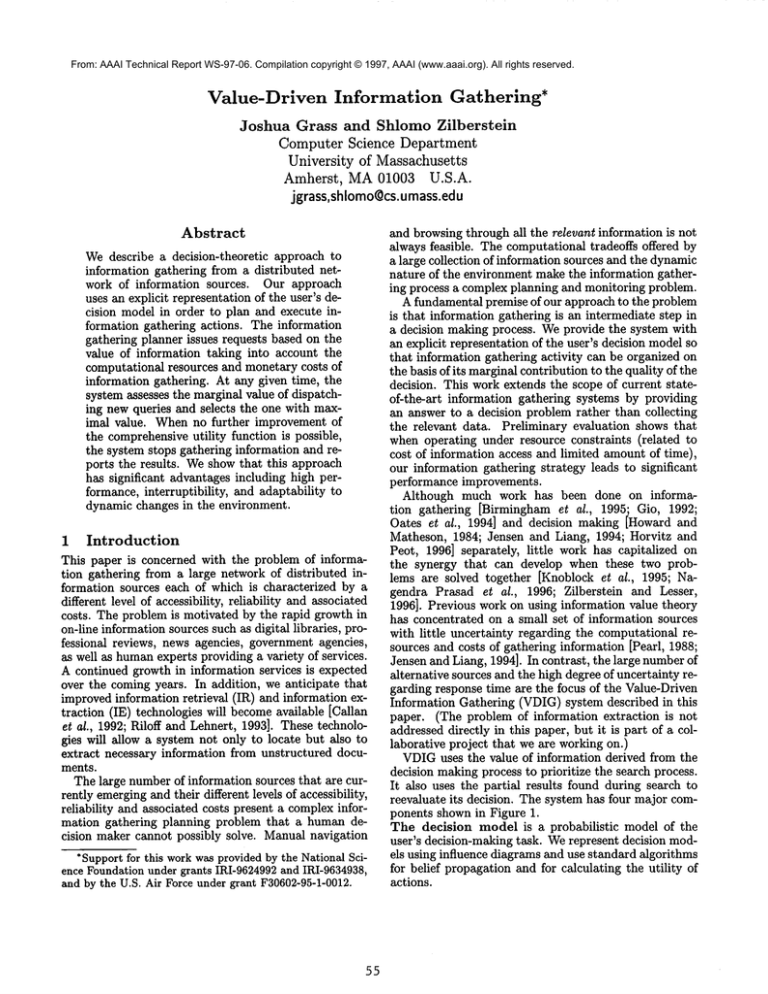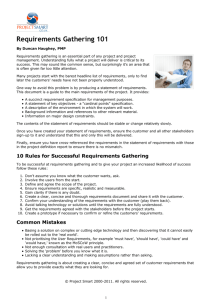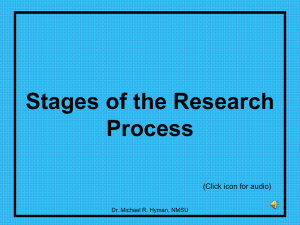
From: AAAI Technical Report WS-97-06. Compilation copyright © 1997, AAAI (www.aaai.org). All rights reserved.
Value-Driven
Information
Gathering*
Joshua Grass and Shlomo Zilberstein
ComputerScience Department
University of Massachusetts
Amherst, MA01003 U.S.A.
jgrass,shlomoC~cs.umass.ed
u
Abstract
Wedescribe a decision-theoretic
approach to
information gathering from a distributed network of information sources. Our approach
uses an explicit representation of the user’s decision model in order to plan and execute information gathering actions. The information
gathering planner issues requests based on the
value of information taking into account the
computational resources and monetary costs of
information gathering. At any given time, the
system assesses the marginal value of dispatching new queries and selects the one with maximal value. Whenno further improvement of
the comprehensive utility function is possible,
the system stops gathering information and reports the results. Weshow that this approach
has significant advantages including high performance, interruptibility,
and adaptability to
dynamic changes in the environment.
1
Introduction
This paper is concerned with the problem of information gathering from a large network of distributed information sources each of which is characterized by a
different level of accessibility, reliability and associated
costs. The problem is motivated by the rapid growth in
on-line information sources such as digital libraries, professional reviews, news agencies, government agencies,
as well as humanexperts providing a variety of services.
A continued growth in information services is expected
over the coming years. In addition, we anticipate that
improved information retrieval (IR) and information extraction (IE) technologies will becomeavailable [Callan
et al., 1992; Riloff and Lehnert, 1993]. These technologies will allow a system not only to locate but also to
extract necessary information from unstructured documents.
The large numberof information sources that are currently emergingand their different levels of accessibility,
reliability and associated costs present a complexinformation gathering planning problem that a human decision maker cannot possibly solve. Manual navigation
*Support for this work was provided by the National Science Foundation under grants IRI-9624992and IRI-9634938,
andby the U.S. Air Force under grant F30602-95-1-0012.
55
and browsing through all the relevant information is not
always feasible. The computational tradeoffs offered by
a large collection of information sources and the dynamic
nature of the environment make the information gathering process a complex planning and monitoring problem.
A fundamental premise of our approach to the problem
is that information gathering is an intermediate step in
a decision making process. Weprovide the system with
an explicit representation of the user’s decision modelso
that information gathering activity can be organized on
the basis of its marginal contribution to the quality of the
decision. This work extends the scope of current stateof-the-art information gathering systems by providing
an answer to a decision problem rather than collecting
the relevant data. Preliminary evaluation shows that
when operating under resource constraints (related to
cost of information access and limited amount of time),
our information gathering strategy leads to significant
performance improvements.
Although much work has been done on information gathering [Birmingham et al., 1995; Gio, 1992;
Oates et al., 1994] and decision making [Howard and
Matheson, 1984; Jensen and Liang, 1994; Horvitz and
Peot, 1996] separately, little work has capitalized on
the synergy that can develop when these two problems are solved together [Knoblock et al., 1995; Nagendra Prasad et al., 1996; Zilberstein and Lesser,
1996]. Previous work on using information value theory
has concentrated on a small set of information sources
with little uncertainty regarding the computational resources and costs of gathering information [Pearl, 1988;
Jensen and Liang, 1994]. In contrast, the large numberof
alternative sources and the high degree of uncertainty regarding response time are the focus of the Value-Driven
Information Gathering (VDIG) system described in this
paper. (The problem of information extraction is not
addressed directly in this paper, but it is part of a collaborative project that we are working on.)
VDIGuses the value of information derived from the
decision makingprocess to prioritize the search process.
It also uses the partial results found during search to
reevaluate its decision. The system has four major components shown in Figure 1.
The decision model is a probabilistic
model of the
user’s decision-making task. Werepresent decision models using influence diagrams and use standard algorithms
for belief propagation and for calculating the utility of
actions.
.
A
\
J
~Cost of time
~
~ function
\
Alist of
\
\feat .... t/utility
\
A set
]
of /
/
sou.r~.
/
]
~pairs"
uescnP7
1
)
/
Figure 1: The major components of the Value Driven
Information Gathering System.
The database of information sources characterizes
each source of information in terms of the type of information it can provide, the associated cost, probabilistic
information about response time, and additional information that tells the system how to interact with the
source.
The communication layer maintains
the pool of
queries that have been sent out but have not yet been
answered. It launches queries in the correct format and
protocol, and it extracts information from the returned
data and sends it to the decision model component.
The value-drive information gathering process is
responsible for planning and monitoring the overall information gathering activity. It uses information from
the other three components to determine what information gathering action to take.
The rest of the paper describes the componentsof the
VDIGsystem in detail. Section 2 describes the representation of decision models and the environment of information sources. In Section 3, we describe the decisiontheoretic information gathering strategy that we implemented. A complete implementation of the system is described in Section 4 along with preliminary results and
evaluation. Weconclude with a discussion of the benefits of VDIGand further work needed in order to apply
the system to large-scaie practical problems.
2
Decision
Sources
Models and Information
This section describes the two primary components that
define the information gathering task, namely the user’s
decision model and the description of the environment
of information sources from which information can be
gathered.
2.1
Decision
Models as Influence
Diagrams
Weuse a standard influence diagram to represent the
user’s decision model. Diagrams representing many useful tasks can be stored in a library so that users would
56
Figure 2: An influence diagram used to decide whether
to take a new job that requires relocation.
only need to retrieve the diagram and modify the utility
function to reflect their specific preference structure. We
prefer this representation because of the availability of
efficient algorithms for belief propagation and because
it provides sufficient data to assess the value of missing
information. However our open system architecture allows for future integration with different representations
of decision models.
To illustrate
the operation of the VDIGsystem and
to evaluate its behavior, we have constructed a sample
decision model, shown in Figure 2, and a corresponding
simulated information environment. The decision model
is designed to help a person evaluate a new job offer that
requires relocation. To make the diagram more readable,
the binary decision (accept or reject offer) is not represented explicitly in the graph. The user’s utility function is based on five major factors: housing quality,
educationquality,safety,job desirabilityand
dispensable
income.Eachfactor,referredto as featuresin this paper, has a small set of discrete values. For
example, education quality can be excellent, good, or
poor. Each feature may depend on a variety of other
features shown in the diagram.
At any given time, standard algorithms for evaluating influence diagrams allow the system to compute the
best action and the its associated utility. The value of
information (VOI) associated with a single feature is the
increase in the expected utility as a result of knowing
the precise value of this feature. (The current version of
the system is based on information sources that return
perfect information. Wewill relax this assumption in
future versions of the system.) It is well knownthat the
a query is issued (regardless of whether the user waits
for the response). Wehave examined more complex cost
models that may be used in future versions of the system.
Additional information related to interaction with each
information source is not discussed in this paper.
Figure 3: The database of information sources
value of information is, in general, non-additive [Howard,
1966]. In other words, the value of information of a set
of features is not necessarily the sumof the value of each
feature. Our system is capable of calculating the exact
value of information of any set of features, but due to
the high computational complexity we limit the size of
the set by a small constant. This allow the system to
make decisions in a non-myopic way with limited computational effort.
2.2
The Environment
of Information
Sources
The VDIGsystem uses a database to describe all the
1.
available information sources and their characteristics
The database maintains information about the type of
information that is available, the associated cost, probabilistic
information about response time, and additional information needed to interact with the information source and extract the necessary information from
the data it returns.
Figure 3 shows the contents of the information sources
database. The responsiveness of each information source
is described by a histogram showingthe probability of information being returned at a given time after the query
is sent (using a discrete representation of time), we refer to this as the result probability histogram. The histogram depends on the state of the information network,
capturing such parameters as load and time of day. The
histogram represents the uncertainty regarding the delay
between the time a query is issued and the time the information becomes available, including both communication time and information extraction time. Once a query
q is issued, the system retrieves from the database appropriate response histogram, Hq(flt), representing the
probability of feature f becomingavailable t time steps
from the current time.
Each information source has a fixed cost charged when
1We do not refer in this paper to any specific information
environment.
An information
source can be a single VCWW
site or, more interestingly,
a smart search engine. We plan
to integrate the VDIGsystem with a specific search engine
currently under development.
57
Information
Gathering
Strategies
3
An information gathering strategy is a method for making the following two decisions:
1. Selecting a new query and sending it to a particular
information source.
2. Deciding when to stop the process of information
gathering and report the best decision based on all
the available information.
The VDIGsystem uses a decision-theoretic
approach
to making these decisions in an attempt to maximize
the comprehensive utility function. At any given time,
the system identifies a small set of k features that are
the focus of information gathering activity. Those are
the k features with highest individual VOI2. Once the
set of features is determined, the system starts to issue
queries and monitor their execution. The following two
subsections give a detailed description of howthe system selects queries and how it decides to stop gathering
information.
Best query selection
3.1
The VDIGsystem activates
queries based on their
marginal value with respect to the currently active information gathering process. The current state of the information gathering process is characterized by the existing
active queries in the query poll Q = {ql, ..., q~}. The system maintains the activation time for each query q~ and
uses it in order to dynamically update the probability
histogram of information arrival time. For each feature,
/, the system calculates a comprehensive histogram of
information arrival time taking into account all the relevant queries in the query pool (assuming independence
of information sources in terms of their response time).
Let HQ(flt ) represent probability of the query pool Q
returning the value of feature f at time t (all times are
measured relative to the current time). Then, the probability of the query pool returning the value of a feature
within n time units is:
n
PQ(fln) = ~’~nQ(flt)
(1)
t=l
The system can also determine the probability that the
current query pool will provide the value of a specific set
of features s at a specific time t. This value is calculated
2The complexity of computing information
value over subsets of features forces us to focus on a small set of features
that appear to be the most valuable ones. The selection
of
the set is myopic, but once queries are activated,
their VOI
takes into account mutual information of features included in
the focus set.
by multiplying the probability of finding each feature in
s by the probability of not finding each feature not in s.
(2)
PQ(sIt) = H PQ(fIt) H(1 - PQ(fIt))
fe8
Job MoveDecision
f~8
To compute the comprehensive utility of the current
query pool at any given time t, the system computes the
expected value of the returned information minus the
associated cost. Whencomputing the expected value
the system does not know what subset of information
will be available at time t. Therefore, it averages over
all possible subsets of features, s, and the corresponding
value of information V(s).
v(QIt) = PQ(slt)V(s) -
C(t) -
(3
I.....
¯c{f
f~}
Note that V(s) is the comprehensive value of information
of the set of features s with respect to the decision model
(this value is computedin a non-myopicway, taking into
account mutual information). C(t) represents the cost
of time and C(Q) represent the monetary cost of all the
queries in the query pool. Obviously, the complexity
of computing the comprehensive value of the query pool
grows exponentially with the size of the feature set under
consideration. That is whywe limit the system to gather
information on a small focus set of up to k features,
{fl,...,fk}.
Because the VDIGsystem decides when to halt, it
determines the utility of the query pool based on the
time that maximizes the comprehensive utility defined
in Equation 3.
U(Q) = arg m,ax U(Qlt)
(4)
Finally, the system computes the marginal value of a
query, q, based on the increase in the expected utility of
the query pool.
UV(q) = U(Q {q} ) - U(Q)
(5)
At any given time, the system considers all possible
queries that maycontribute information on the features
in the current focus set. It selects the query that has
the highest marginal contribution, MV(q). If no query
has a positive marginal value, the system will not issue
any new queries at the current time slice. Later on,
the system may issue new queries if some information
source falls to return valuable information or if the value
associated with some feature is increased based on the
actual information acquired.
Stopping criterion
3.2
A decision by the system to stop gathering information
is reached when the cost of information gathering becomes greater than the benefits. In other words, when it
reaches a global maximumof the comprehensive utility
function of the query pool. The stopping criterion is:
Vt : V(Qlt ) < U(QIO)
(6)
Since the system re-evaluates the stopping criterion every time slice, it can handle possible changes in the cost
model in a dynamic environment or it can be simply
interrupted by the user if necessary.
58
Figure 4: The underlying belief network used by the
system to evaluate a new job offer.
4
Experimental
Results
Wehave implemented the VDIGsystem and tested it using a simulated information environment. The planner,
information sources database and communication layer
were developed in Common
Lisp, and the decision model
is implemented using the Hugin belief network library.
In part one of this section we describe the implementation of the VDIGsystem and examine the system gathering information for a moderately sized decision model.
Part two compares the VDIGsystem with three other
approaches to solving decision problems.
4.1
Implementation
Wetested the VDIGsystem using the decision model introduced in Section 2.1. The main decision is whether to
take a new job that requires relocation. In order to make
this type of decision, information has to be collected from
many disparate sources. Figure 4 shows the underlying belief network representing this decision model. The
probabilistic information attached to each node represent the initial state before information is gathered.
job desirability
disposableincome
safety
housingquality
1.560
1.405
1.180
I.I00
Figure 5: The initial value of information for the four
most valuable nodes
Whenthe VDIGsystem is initiated it first evaluates
the value of information for each individual node in the
decision model. The value of information calculated at
disposablesafety housing VOI
job
desirability income
quality
X
1.560
X
1.405
2.0
X
X
X
1.180
X
X
X
X
X
X
X
2.179
2.538
Figure 6: The value of information for each possible set
of nodes in the focus set
Figure 9: The result probability histogram at time 1 (left)
and 2(right) for the feature housing quality.
Bm
Figure 10: Utility curve at time 8(left) and 9(right).
Figure 7: The result probability histograms at time 0.
this stage does not take into account the cost of gathering information. It is calculated using the classical
definition of value of information which is the increase
in the expected utility of the best action once the information is acquired [Pearl, 1988]. Table 5 shows the four
highest scoring nodes in the decision modelthat together
define the current focus set of features. Table 6 shows
the value of different sets of features in the focus set.
These set values are used in equation 2 to determine the
comprehensiveutility.
The value of information for each node changes as
nodes are instantiated, so when information is returned
by the communicationlayer, the value of information for
the remaining uninstantiated nodes must be updated.
Figure 8: The comprehensive utility
at time 0.
Using the value of information for each possible set
and the information sources database, the VDIGsystem can calculate the marginal utility for activating any
query. Our implementation picks the two highest scoring queries and activates them. In our example the two
queries that were launched during the first time slice
return job desirability
and disposable income(see
Figure 7). Launchingthese two queries increased the expected utility by 0.546. The comprehensive utility curve
59
is shown in Figure 8 with the white bar indicating the
maximumutility point.
At time slice 1 the VDIGsystem launches a query that
will return the housing quality and safety. Both the
job desirability
and the disposable income probability histograms are unaffected. At time slice 2 the
VDIGsystem adds two more queries that also return
housing quality and safety.
Figure 9 shows how
adding another query for housing quality changes the
result probability histogram.
The VDIGsystem continues adding queries to the
query pool as long as the marginal utility increases. As
information starts arriving, the change in the value of
additional information can decrease causing the VDIG
system to halt. At time slice 9, information on housing
quality was returned. Figure 10 shows how the comprehensive utility decreased from 1.009 to 0.755. In this
example, the VDIGsystem stops at time 10 after receiving the value of safety.
4.2
Comparison
Wecompared the VDIGsystem against three other information gathering strategies. The first takes the best
action (take the job) given the initial decision model
without gathering any information. The second is a
naive strategy that does not use the decision model and
the responsiveness of the information sources. It gathers
information in an attempt to cover all of the relevant features regardless of their corresponding values. The third
strategy is an ideal approach that makes the optimal
decision in each case (pretending that accurate information is available at no cost). This is the upper bound on
the performance of any information gathering technique.
The results are summarized in Table 11.
The table highlights the importance of a value driven
approach to information gathering. The naive coverage
approach, given the same constraints, does not score sig-
Utility
Correct
Always
Move
0.900
59%
Coverage
1.150
60%
VDIG
System
2.066
86%
Figure 11: A comparison of different
ering strategies
Best
case
3.090
100%
information gath-
nificantly higher then the base-line approach of making
a decision without any knowledge. This is due largely
to the fact that sources in this information environment
had a significant uncertainty regarding the timing and
success of returning information. The VDIGsystem
could compensate for this by querying multiple information sources when the chance of any one returning
a result was low, and not wasting resources trying to
gather pieces of information that were of little use to the
overall decision.
5
Conclusion
In this paper we have described a value-driven information gathering system which uses information from both
the decision side and the acquisition side of an information gathering problem in order to implement an effective information gathering strategy. With the growth
in the number of distributed information systems and
the increasing strain placed on these systems by users,
a value driven approach to information gathering can
gather more beneficial information under the same time
and resource constraints than other approaches. Although further evaluation is needed to fully understand
the benefits of our system, it is clear that value driven information gathering works best with problems in which
the information environment offers multiple sources for
the same information with different cost and response
characteristics.
The benefits of the system grow when
there is a high degree of uncertainty regarding the performance of each information source.
Further work on the VDIGsystem is aimed at integration with existing search engines and information extraction techniques, handling inaccurate and conflicting
information from different information sources, and enhancing the interaction with the information sources and
the cost of information model. Our overall goal in this
research is to create a system that takes advantage of a
deep understanding of its external and internal resources
in order to gather information in the most effective way.
References
[Birmingham et al., 1995] W. P. Birmingham, E. H.
Durfee, T. Mullen, and M. P. Wellman. The distributed agent architecture of the University of Michigan digital library. AAAI Spring Symposiumon Information Gathering in Heterogeneous, Distributed Environments, Stanford, California, 1995.
[Cailanetal.,
1992] J. Callan, W. B. Croft, and
S. Harding. The inquery retrieval system. Proceed-
6O
ings of the 3rd International Conference on Database
and Expert Systems Applications, pp. 78-83, 1992.
[Gio, 1992] W. Gio. The roles of artificial intelligence in
information systems. Journal of Intelligent Information Systems, 11(1):35-56, 1992.
[Horvitz and Peot, 1996] E. Horvitz and M. Peot. Flexible strategies for computingthe value of information
in diagnostic systems. Proceedings of the AAAI Fall
Symposium on Flexible Computation in Intelligence
Systems, pp. 89-95, Cambridge, Massachusetts, 1996.
[Howard, 1966] R. A. Howard. Information value theory.
IEEE Transactions on Systems Science and Cybernetics, SSC-2(1):22-26, 1966.
[Howard and Matheson, 1984] R. A. Howard and J. E.
Matheson. Influence diagrams. Principles and applications of decision analysis, 2, 1984.
[Knoblock et al., 1995] Knoblock, Craig A., and Levy,
Alon Y. Exploiting Run-Time Information for Efficient Processing of Queries. In Working Notes of the
AAAI Spring Symposium on Information Gathering
from Heterogeneous, Distributed Environments, Stanford University, Stanford, CA, March, 1995.
[Jensen and Liang, 1994] F. Jensen and J. Liang. A
system for value of information in bayesian networks. Proceedings of the 1994 Conference on Information Processing and Managementof Uncertainty in
Knowledge-Based Systems, pages 178-183, 1994.
[Nagendra Prasad et al., 1996] M. V. Nagendra Prasad,
V. Lesser, and S. Lander. Reasoning and retrieval
in distributed case bases. Journal of Visual Communication and Image Representation, Special Issue on
Digital Libraries, 1996. To appear.
[Oates et al., 1994] T. Oates, M. Nagendra Prasad, and
V. Lesser. Cooperative information gathering: A
distributed problem-solving approach. Technical Report 66, University of Massachusetts, 1994.
[Pearl, 1988] J. Pearl. Probabilistic Reasoning in Intelligent Systems: Networks of Plausible Inference.
Morgan-Kanfmann,Los Altos, California, 1988.
[Riloffand Lehnert, 1993] E. Riloff and W. Lehnert.
Automated dictionary construction for information
extraction from text. In Proceedings of the ninth IEEE
Conferenceon Artificial Intelligence for Applications,
pages 93-99, 1993.
[Zilberstein, 1996] S. Zilberstein. The use of anytime
algorithms in intelligent
systems. AI Magazine,
17(3):73-83,1996.
[Zilberstein and Lesser, 1996] S. Zilberstein and V.
Lesser. Intelligent information gathering using decision models. Technical Report 96-35, Computer Science Department, University of Massachusetts, 1996.







